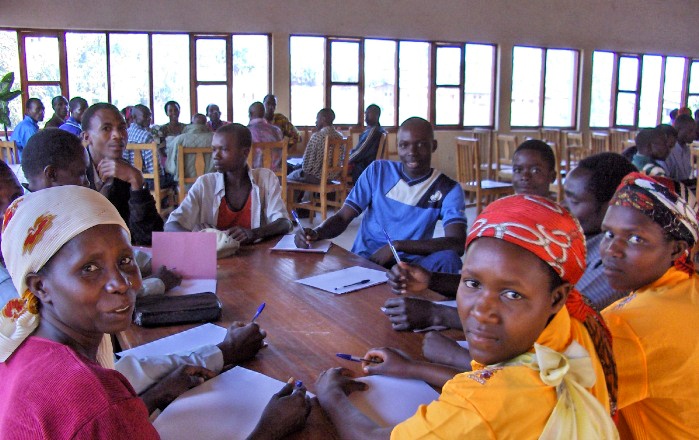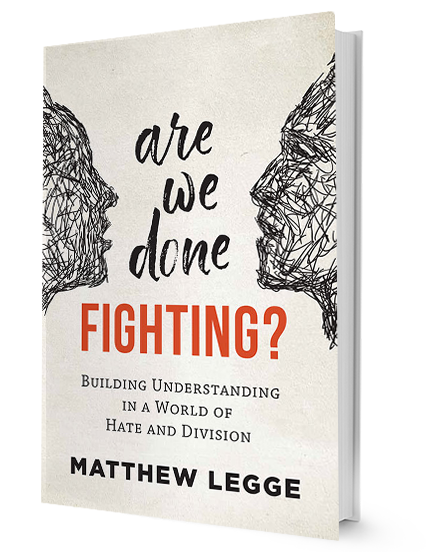
A Congolese woman looks out of her hotel window to see a group in the street starting a loud protest, while a large number of soldiers advances on them.
Instead of staying inside and watching, she walks out into the street, alone. She places herself right in the middle of the street, between the two sides.
From behind her come the angry shouts of the mass of townspeople. In front, she sees the well-armed soldiers drawing ever closer.
With calm perseverance and fearlessness, the woman begins to talk to both sides. She listens carefully, and reminds them of their real interests in this situation. Will they hear?
Things are tense and violence could erupt at any moment as insults are hurled back and forth. But with time, the situation cools.
Both groups start to understand that their interests can be served without violence. Eventually, incredibly, the townspeople and the soldiers disperse.
This is a true story. It is one of an endless number of examples of nonviolence in support of justice and of peace.
Did you know that skills like these exist and are used every day around the world? How many violent situations are creatively transformed (and don’t become news)? How would you react in a conflict situation that you saw escalating?
You have more power than you think
In 2019, after years of reflection, research, and writing, CFSC’s book Are We Done Fighting? Building Understanding in a World of Hate and Division was published. The book collects and shares wisdom from remarkable peacebuilders from all over the world, both Quaker and non-Quaker. Peace education based on this book remains an ongoing focus of our work.
 Right now there are places where hate is on the rise. That’s deeply disturbing, but it isn’t inevitable. Responding strategically and with care is vital if we’re going to turn the tide. How can we do it?
Right now there are places where hate is on the rise. That’s deeply disturbing, but it isn’t inevitable. Responding strategically and with care is vital if we’re going to turn the tide. How can we do it?
It turns out that a lot of our “common sense” approaches don’t work. But this book, full of carefully collected research and practical tips about what does work, is poised to be a game-changer. Discover your power, and the surprising ways you can use it.
There’s no one single secret to building justice and peace. And there are never any guarantees that our efforts will be successful. There are, however, many techniques that we can learn to use if we’re aware that they exist and if we don’t just imagine, incorrectly, that they must be impossible.
Are We Done Fighting? offers short chapters full of tips, exercises, and plenty of evidence to explain what’s happening when violence and hate rise, and when peace does.
Find out more on the book’s website AreWeDoneFighting.com
Join us for free online interactive workshops using content and exercises from the book.
See what people are saying about the book.
Read our ongoing blog Are We Done Fighting? over at Psychology Today.
Our definition of peace: what we mean by a culture of peacemaking
“Peace is not merely the absence of some negative force—war, tensions, confusion but it is the presence of some positive force—justice, goodwill, the power of the kingdom of God.”—Martin Luther King, Jr.
After years of reflection and discernment, CFSC joined a long tradition of nuanced peace thinkers from Martin Luther King, Jr. to Johan Galtung (who coined the terms negative and positive peace).
The definition emerged that, for us, peace is not about perfection or utopia. Peace is not a hiding place away from the strife and discord of the world. It’s much more dynamic. Peace as a living system will always include conflicts and major differences of need, feeling, and experience. CFSC encourages conflicts to be more constructive than destructive, and, most importantly, to be actively nonviolent.
We believe that peace is always possible. Neither peace nor violence is inevitable. Relationships, social, and political structures can influence us toward peace or toward violence.
CFSC chose the uncommon term a “culture of peacemaking” rather than the common “culture of peace” to highlight that, for us, peace needs to be continually built.
CFSC thinks of three levels through which the culture of peacemaking flows:
- inner peace—attitudes, beliefs, and habits conducive to peace
- interpersonal peace—peace in interactions with other people
- structural peace—political and social structures that support peace.
Each is simultaneously influenced by, and influencing, the others. Peace-oriented social and political structures will encourage more peaceful interactions between people. More interpersonal peace will help us achieve more inner peace. Structural peace will be promoted when we understand and value inner and interpersonal peace and use it to recognize, and seek to distance our societies from, violence.
Our definition of peacemaking applies equally to any country, whatever its present relationship to violent conflict. Because the conditions around us play such a major role in the decisions we make, peaceful conditions must be continually built. This process is complex and unpredictable, so peace must be cultivated responsively and with care.
CFSC considers the following interconnected elements central to a culture of peacemaking:
Justice—This includes well-balanced systems of laws and standards, conflicts being dealt with consistently, protection of dissent, and fostering respect for the full human rights, dignity, and participation of all. Social institutions can’t be founded on principles of retribution, exploitation, domination, or unsustainable use of resources. Because we live in a global and interdependent community, justice includes right relationships with others (other individuals, communities, nations, and species). Problems can’t just be exported elsewhere in the web of relationships.
Opportunities—We need culturally appropriate, safe, and ethical services and entry points into a life that holds meaning for us as individuals and communities. This includes education and child services, health services, housing, livelihoods, proper sanitation, arts, nutritious food and safe water, chances for fun and games, a sustainable pace of life, places and time enough to connect with the natural world of which we are a part, and opportunities for spiritual expression. We need a sense of control in our lives, within fair boundaries.
Active support for peaceful change—Cultures are not static; new ideas and directions are always emerging. Tension is inherent in such change. All elements of society need loving and supportive care, and space must be made to listen and encourage positive changes on a continual basis, while also maintaining and invigorating important traditions.
Skills—to live peacefully takes skill (as detailed in our peace education work).
Whatever CFSC can do to encourage peace is part of peacemaking. This is clearly a vast definition, rather than a narrow or technical one. Peacemaking is work that Friends historically, and still today, feel led to. It’s an expression of all of CFSC’s values, rooted in the Quaker testimonies of peace, integrity, equality, simplicity, community, and respect for all creation.
Quaker peacemaking arises from what early Friend George Fox said was our call to live “in the virtue of that life and power that takes away the occasion of all wars.” This is manifested in:
- Respect for that of God in everyone
- Witness against war, violence, militarism, and hatred
- Examining, questioning, and engaging with the roots and with the manifestations of violence in ourselves, our own social world, and the larger world of which we are part
- Discerning and nurturing new growing points in creating a just and compassionate society
- Exercising our responsibilities as members and citizens of our local, national, and international communities
- Maintaining strict integrity in all our conduct
- Standing firm in nonviolence.


